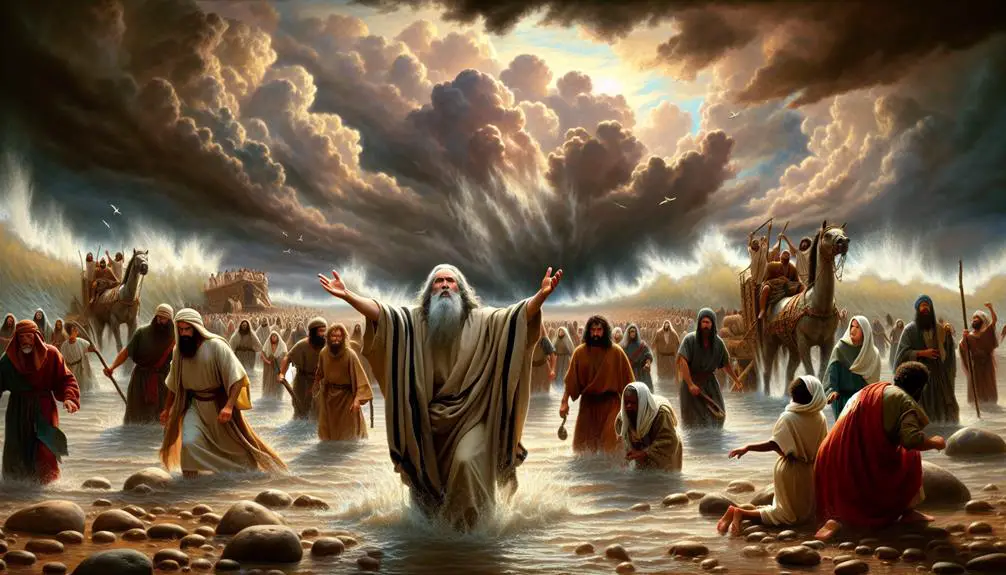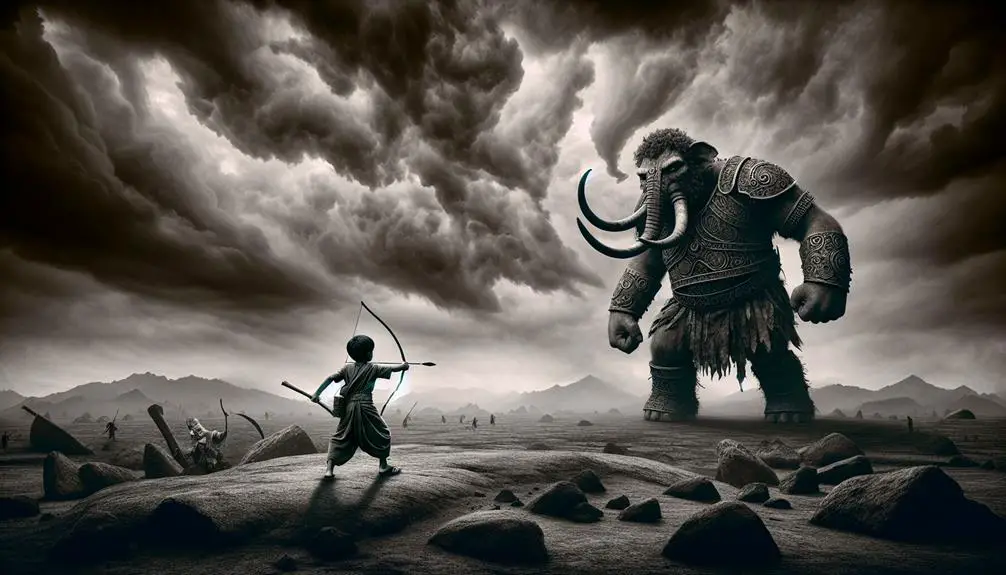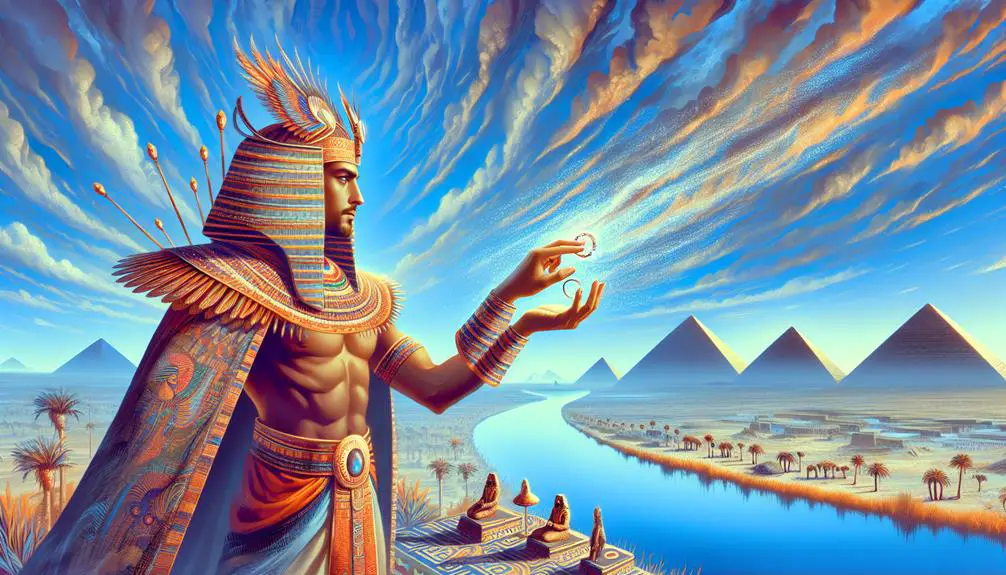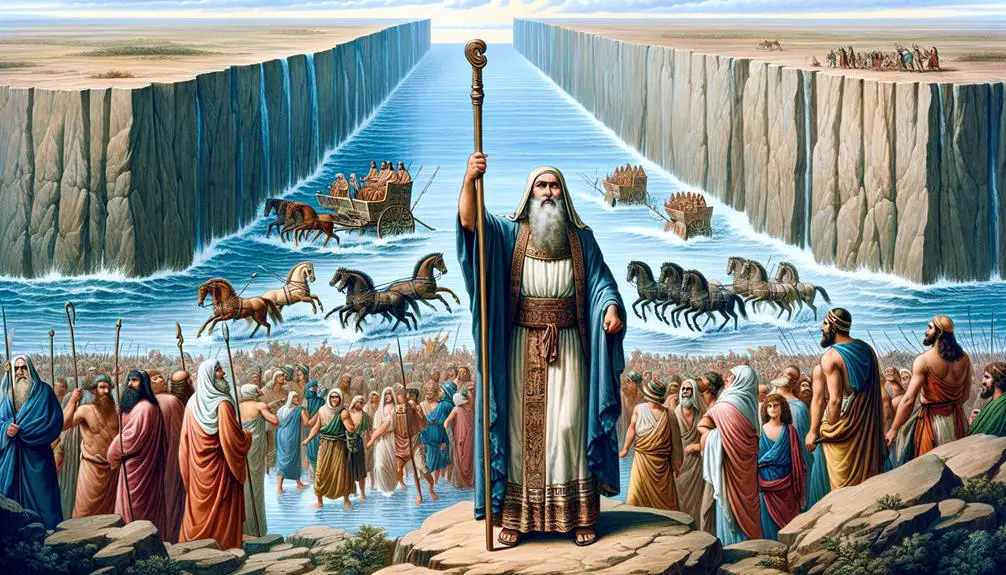Marvel at ancient tales of deliverance in the Bible, and uncover the timeless wisdom they hold for facing today's challenges.

Stories of Deliverance in the Bible
The Bible, an ancient text revered by millions, is replete with narratives that speak to the human spirit's resilience and the profound concept of deliverance. From the awe-inspiring account of the Exodus from Egypt to the symbolic salvation represented by Noah's Ark, these stories transcend time, offering insights into divine intervention and human perseverance.
As we explore these tales, we realize they are not merely historical recounts but are imbued with lessons that resonate deeply with contemporary challenges. The question then arises: what modern interpretations and meanings can we derive from these ancient narratives of deliverance?
Key Takeaways
- Divine intervention plays a pivotal role in delivering the faithful from peril, underscoring themes of faith and obedience.
- Stories of triumph, like David and Goliath, highlight the power of unwavering faith and courage against seemingly insurmountable odds.
- Biblical narratives of transformation and redemption, such as the Exodus and Noah's Ark, offer profound lessons on liberation and divine mercy.
- Leadership intertwined with divine wisdom, as seen in Joseph's rise in Egypt, showcases the impact of divine providence on human affairs.
The Exodus From Egypt

The Exodus from Egypt, one of the most pivotal events in the Hebrew Bible, represents a profound narrative of liberation, wherein the Israelites were delivered from centuries of slavery under Pharaoh's rule. This momentous event, rich in theological and historical implications, is anchored by two key figures: Moses and Pharaoh, whose interactions define the course of this epic saga. Moses' leadership, characterized by unwavering faith and divine guidance, stands in stark contrast to Pharaoh's stubbornness, an embodiment of tyranny and defiance against the will of God.
Analyzing Moses' leadership reveals a complex figure, one who is initially reluctant yet grows into his role as a leader through divine intervention and personal conviction. His ability to confront Pharaoh, perform miracles, and ultimately lead his people out of Egypt showcases a divinely sanctioned mission, emphasizing themes of faith, obedience, and redemption. Conversely, Pharaoh's stubbornness not only serves as a narrative foil to Moses but also highlights a broader theme of hubris versus divine will. Each refusal to let the Israelites go, despite the plagues devastating his land, underscores a deeper resistance to change and acknowledgment of a power beyond his comprehension.
The Exodus story, therefore, is not merely a historical recount but a rich tapestry of themes and characters, with Moses' leadership and Pharaoh's stubbornness providing critical lenses through which to understand this epic narrative. It encapsulates a collective memory of enslavement and deliverance, serving as a foundational myth that has shaped the identity and faith of the Jewish people through the ages.
Noah's Ark and the Flood

Transitioning from the Exodus narrative, we now turn our attention to the story of Noah's Ark and the Flood, a foundational deliverance story with profound theological implications.
This narrative not only explores the Ark's symbolic significance as a vessel of salvation but also examines the Flood's global impact, highlighting themes of judgment, mercy, and renewal.
Through a critical analysis of these elements, we can gain deeper insights into the narrative's role within the broader tapestry of biblical deliverance stories.
Ark's Symbolic Meaning
Within biblical narratives, Noah's Ark embodies a profound symbol of salvation and divine mercy amidst catastrophic destruction. Its construction, as dictated by divine instruction, showcases not just advanced naval architecture for its time but also a tangible manifestation of faith and obedience.
The Ark, far beyond its physical structure, serves as a covenant symbol between the Divine and humanity, a testament to the possibility of renewal and redemption. This floating vessel of salvation encapsulates the theme of deliverance, highlighting a pathway from wrath to grace.
Through its story, the Ark becomes more than a means of survival; it transforms into a profound metaphor for divine providence, offering a blueprint for spiritual resilience and the promise of a new beginning amidst the world's moral and physical upheavals.
Flood's Global Impact
Noah's Ark and the ensuing Flood represent a pivotal moment in biblical history, marking not only a divine intervention but also a global cataclysm that reshaped humanity's trajectory and its relationship with the Creator. The narrative, while deeply theological, intersects with discussions on climate change and archaeological evidence, offering a unique lens through which to view ancient environmental upheavals.
Scholars have debated the historical and geographical implications of this event, probing for evidence that parallels or elucidates ancient accounts of widespread flooding. This inquiry not only enriches our understanding of the biblical text but also frames the Flood narrative within a broader discourse on how ancient civilizations might have interpreted and adapted to dramatic shifts in their climate, providing a fascinating intersection of faith, history, and science.
Daniel in the Lion's Den

Among the most compelling narratives of divine intervention in the Hebrew Bible is the story of Daniel in the Lion's Den, which epitomizes faith under duress and divine deliverance from seemingly insurmountable peril. This story serves as a profound testament to the themes of steadfast faith, divine protection, and the triumph of good over evil. It unfolds in the context of Daniel's unwavering devotion to God in the face of a decree that outlawed prayer to any deity or man other than the king. Daniel's subsequent punishment, being thrown into a den of lions, and his miraculous survival, underscore the power of faith and prayer.
The lions' symbolism in this narrative is multifaceted, representing both the mortal danger posed by adherence to one's faith in a hostile environment and the potential for divine intervention to render such threats impotent. The lions, fierce and predatory, are transformed into harmless beings, highlighting the transformative power of divine will when faith is unwavering.
Prayer's power is central to Daniel's story, serving as both the cause of his persecution and the means of his deliverance. Daniel's commitment to prayer, even when faced with death, illustrates the profound belief in God's omnipotence and mercy. The narrative suggests that prayer is not merely a ritualistic practice but a powerful act of faith capable of invoking divine intervention in the most dire circumstances.
Jonah and the Great Fish

Similar to Daniel's demonstration of faith, the narrative of Jonah and the Great Fish offers another profound exploration of divine intervention and the complexities of human obedience to God's will. The story, deeply embedded within the tapestry of biblical deliverance narratives, underscores the themes of repentance, mercy, and redemption, not just on an individual level with Jonah's repentance but also on a communal scale with Nineveh's redemption.
The account begins with Jonah's initial refusal to heed God's command to prophesy against Nineveh, leading to his encounter with the great fish—a divine instrument of both judgment and grace. This moment of crisis compels Jonah towards introspection and repentance, illustrating the transformative power of divine chastisement. Through Jonah's repentance, the narrative articulates a profound truth about the human condition: the potential for change and redemption in the face of divine intervention.
Furthermore, the eventual preaching to Nineveh and its subsequent redemption expand the scope of the narrative from personal to collective deliverance. Nineveh's redemption serves as a testament to the boundless mercy of God, who extends forgiveness not only to the wayward prophet but also to an entire city upon their repentance. This dual focus on Jonah and Nineveh encapsulates the biblical ideal of a repentant heart leading to divine deliverance.
David and Goliath

The narrative of David and Goliath embodies a profound exploration of faith, defiance, and the ramifications of victory in biblical deliverance stories.
Goliath's challenge to the Israelites not only represents a literal giant but also symbolizes the colossal obstacles faced by those who seek to uphold their faith under duress.
David's response, grounded in unyielding faith rather than conventional warfare, underscores the narrative's emphasis on divine support as the cornerstone of overcoming seemingly insurmountable odds.
Goliath's Defiance
In the biblical narrative of David and Goliath, Goliath's defiance emerges as a central theme, showcasing his challenge towards the Israelite army and the God they serve. This towering Philistine, clad in imposing armor, embodies not just physical might but also the spiritual and psychological warfare waged against the Israelites. His taunts and provocations serve as a critical test of faith and resolve.
- Goliath's Philistine armor symbolizes the formidable military technology and culture of his people, emphasizing the apparent disparity in strength.
- The sling technique used by David later highlights an unconventional approach to warfare, contrasting with Goliath's reliance on traditional arms and armor.
- Goliath's challenge represents not just a personal duel but a larger conflict between opposing faiths and deities.
This defiance sets the stage for an exploration of faith, courage, and divine intervention in the face of overwhelming odds.
David's Courageous Faith
Amidst the towering challenge posed by Goliath, David's unwavering faith emerges as a beacon of divine courage and foresight, setting a profound precedent for overcoming insurmountable odds through spiritual conviction.
The narrative contrasts Goliath's intimidating physical armor with the spiritual armor David garners through his psalms, underscoring a pivotal theme in biblical literature: the triumph of faith over material might.
David's reliance on divine support, articulated through his psalms, not only prefigures his victory but also encapsulates a broader theological motif—divine deliverance irrespective of earthly power dynamics.
This story, therefore, serves as an analytical cornerstone for understanding the interplay between faith, courage, and divine intervention in biblical deliverance narratives, offering a rich contextual framework for interpreting the enduring significance of spiritual conviction in the face of adversity.
Victory's Impact
David's triumph over Goliath reverberated through the annals of biblical history, marking a watershed moment in the narrative of divine deliverance and human faith. This victory was not merely a tale of physical conquest; it signified a deeper spiritual renewal and provided a foundation for emotional healing among the Israelites.
The implications of David's victory were manifold:
- It underscored the power of faith and reliance on divine providence.
- It heralded a new era of leadership and moral fortitude, embodied by David.
- It catalyzed a collective spiritual awakening and emotional healing within the community.
Analyzing this pivotal event reveals how individual acts of courage can precipitate widespread spiritual renewal, fortifying the collective resolve and fostering a deeper, communal sense of emotional healing.
Joseph's Rise in Egypt

Joseph's ascent to prominence in Egypt, a narrative marked by divine intervention and astute political acumen, exemplifies a profound deliverance story within the biblical canon. This account, deeply embedded in the fabric of religious and moral teachings, showcases Joseph's journey from enslavement and imprisonment to becoming one of the most powerful figures in Egypt, second only to Pharaoh. Central to this trajectory are two pivotal elements: dream interpretation and the implementation of economic strategies, which not only underscore Joseph's wisdom but also illustrate the divine orchestration at play.
Joseph's ability to interpret dreams, a skill that finds him favor with Pharaoh, serves as the initial catalyst for his rise. This unique capability, which he attributes to God, allows him to unveil the meanings behind Pharaoh's enigmatic dreams, predicting seven years of abundance followed by seven years of famine. His interpretations are not just acts of deciphering but are imbued with divine insight, positioning him as a conduit for divine wisdom in a polytheistic society.
Following the interpretation, Joseph's proposal of economic strategies to store surplus grain during the years of abundance demonstrates his foresight and administrative prowess. This plan not only secures Egypt's survival during the subsequent famine but also establishes Joseph as an indispensable asset to Pharaoh and the Egyptian empire. His elevation from a foreign Hebrew slave to the architect of Egypt's salvation encapsulates a narrative of deliverance and redemption, underscoring the themes of resilience, divine favor, and the wisdom to navigate and mitigate impending crises. Through Joseph's story, the biblical text delineates the interplay between divine providence and human agency, highlighting how faith and action can lead to deliverance and prosperity.
The Parting of the Red Sea

The Parting of the Red Sea stands as one of the most emblematic episodes of divine intervention in the Bible, symbolizing the deliverance of the Israelites from Egyptian bondage. This event is a pivotal moment in the biblical narrative, showcasing not only a miraculous act by God but also highlighting the themes of faith, leadership, and liberation. At the heart of this story are the contrasting characters of Moses and the Pharaoh, each representing different facets of the human experience and divine interaction.
Moses' leadership is crucial to the narrative. Entrusted with the daunting task of leading the Israelites out of Egypt, Moses embodies humility, obedience, and faith. His ability to follow divine instructions, even when faced with seemingly insurmountable obstacles, serves as a testament to his faith and the power of divine guidance.
- Moses' steadfast faith and leadership under divine command
- Pharaoh's heart, hardened against the Israelites' release, symbolizing resistance to divine will
- The miraculous parting of the Red Sea, a dramatic demonstration of divine power and deliverance
The hardening of Pharaoh's heart is a recurring theme that culminates in this moment of deliverance. It serves as a narrative device to amplify the power of God's intervention, contrasting divine mercy with human stubbornness. The parting of the Red Sea, therefore, is not just a physical escape route for the Israelites but a profound demonstration of the consequences of faith and defiance.
This story, rich in symbolism and lessons, continues to inspire and instruct, highlighting the timeless themes of liberation, faith, and the complexities of leadership under divine guidance.
Frequently Asked Questions
How Have Modern Archaeological Findings Influenced the Understanding and Interpretation of These Biblical Deliverance Stories?
Modern archaeological findings, through the lens of artifact authenticity and advanced technological methods, have significantly impacted the understanding and interpretation of ancient narratives.
The discovery of artifacts and application of technologies like radiocarbon dating and geographic information systems offer concrete evidence that contextualizes historical accounts.
This scholarly approach not only validates certain events but also provides a deeper insight into the cultural and societal conditions of the periods in question, enhancing academic and public comprehension.
In What Ways Have These Stories of Deliverance Been Depicted in Contemporary Art, Music, and Literature Outside of Religious Texts?
Contemporary artistic expressions, including art, music, and literature, often incorporate symbolic representations and adaptations of themes of liberation and redemption. Artistic symbolism frequently explores these narratives through visual mediums, translating profound ancient motifs into modern contexts.
Similarly, musical adaptations have reinterpreted these themes, infusing them with contemporary resonance. These creative endeavors not only enrich cultural dialogues but also offer fresh perspectives on enduring human experiences of struggle and triumph.
How Do Different Religious Denominations Interpret the Moral and Theological Lessons of These Deliverance Stories Differently?
Navigating the intricate tapestry of denominational differences reveals a kaleidoscope of interpretive diversity regarding moral and theological lessons.
This analytic exploration, devoid of specific biblical narratives, delves into how various religious denominations diverge and converge in their understanding of these teachings.
Scholarly inquiry into this context highlights the richness of theological discourse, underscoring the nuanced ways in which faith communities dissect and assimilate the underlying principles of these profound stories.
What Psychological Impacts Do These Stories of Deliverance Have on Believers and Non-Believers Alike When They Encounter Them in Various Contexts?
The inquiry into the psychological impacts of deliverance narratives on both believers and non-believers reveals significant insights into emotional resilience and narrative therapy.
These stories, irrespective of their religious origins, offer a framework for individuals to interpret and navigate personal challenges, fostering a sense of hope and perseverance.
Through analytical and scholarly examination, it becomes evident that such narratives can play a pivotal role in shaping one's mental and emotional well-being in various contexts.
Can Parallels Be Drawn Between These Biblical Stories of Deliverance and Similar Narratives Found in Other Ancient Cultures or Religions?
Certainly, parallels can be drawn between narratives of deliverance found within ancient cultures or religions, highlighting cross-cultural similarities and mythological comparisons.
By juxtaposing these tales, one can observe a common thematic thread of triumph over adversity, a motif resonant across different civilizations.
This analytical approach underscores the universal appeal of such stories, providing a contextual framework that bridges distinct mythologies, thereby enriching our understanding of shared human experiences and values.
Conclusion
In conclusion, the stories of deliverance in the Bible encompass themes of faith, divine intervention, and redemption, serving as foundational narratives for believers. They illustrate the power of belief and the potential for human beings to overcome insurmountable obstacles through divine assistance.
For instance, the tale of David and Goliath echoes in various contexts where individuals face seemingly unconquerable challenges, yet emerge victorious, underscoring the timeless relevance of these ancient narratives in inspiring contemporary resilience and faith.



Sign up